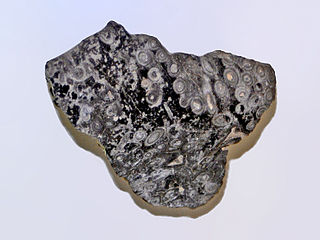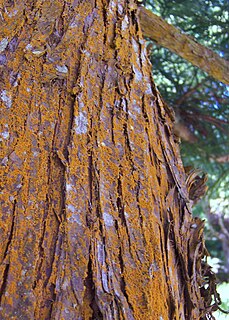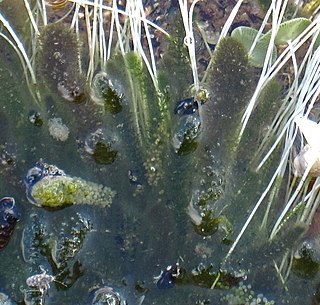
The National Center for Biotechnology Information (NCBI) is part of the United States National Library of Medicine (NLM), a branch of the National Institutes of Health (NIH). It is approved and funded by the government of the United States. The NCBI is located in Bethesda, Maryland and was founded in 1988 through legislation sponsored by US Congressman Claude Pepper.

The Deltaproteobacteria are a class of Proteobacteria. All species of this group are, like all Proteobacteria, Gram-negative.
Asteriscium is a genus of flowering plant in the family Apiaceae, with about 8 species. It is endemic to temperate South America.
Chlorocystidales is an order of green algae belonging to the class Ulvophyceae. The order consists only one family: Chlorocystidaceae.

The Dasycladaceae is one of the two extant families of green algae of the order Dasycladales. When found in Palaeozoic limestones, they typically indicate depositional depth of less than 5m.
Chlamydopodium is a genus of green algae in the family Characiochloridaceae.
Oltmannsiellopsis is a genus of marine colonial flagellate green algae in the Oltmannsiellopsidaceae family of Chlorophyta. It was named in reference to the similar genus Oltmannsiella. It has three species, O. viridis, which forms four-celled colonies, O. unicellularis, which is single celled, and O. geminata, which forms two-celled colonies. In Japanese it is called ウミイカダモ.

Trentepohlia is a genus of filamentous chlorophyte green algae in the family Trentepohliaceae, living free on terrestrial supports such as tree trunks and wet rocks or symbiotically in lichens. The filaments of Trentepohlia have a strong orange colour caused by the presence of large quantities of carotenoid pigments which mask the green of the chlorophyll.

Valonia is a genus of green algae in the Valoniaceae family. The cells have multiple nuclei and many chloroplasts, each with a pyrenoid. The cells of some species are very large, up to 2 cm in diameter. In some species the colonies maintain a symmetrical shape but in others they do not. Some species have been extensively used for studies of ion-exchange and water potential across biological membranes.

Batophora oerstedii is a species of algae in the family Dasycladaceae. It is the type species (holotype) of the genus Batophora.

Analipus japonicus, or sea fir, is a brown alga species in the genus Analipus.

Hapalidiaceae is a family of red alga belonging to the order Corallinales.

Desmarestia anceps is a species of brown algae found in the Antarctic Peninsula.
Yuyuevirus is a genus of negative-strand RNA viruses which infect invertebrates. Member viruses have bisegmented genomes. It is the only genus in the family Yueviridae, which in turn is the only family in the order Goujianvirales and class Yunchangviricetes. Two species are recognized: Beihai yuyuevirus and Shahe yuyuevirus.









